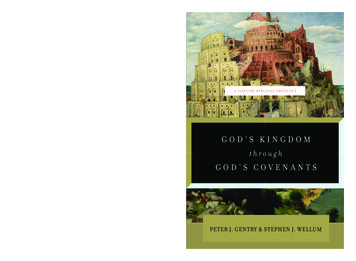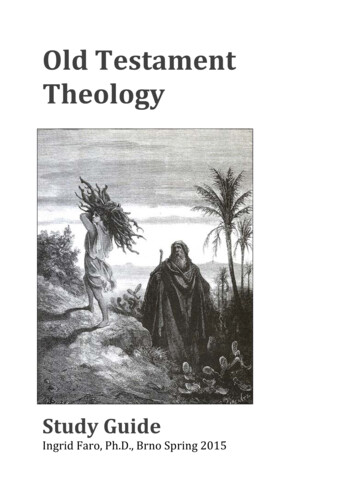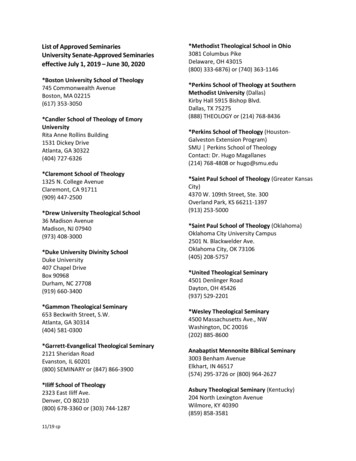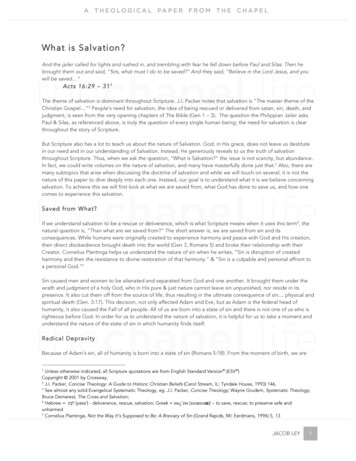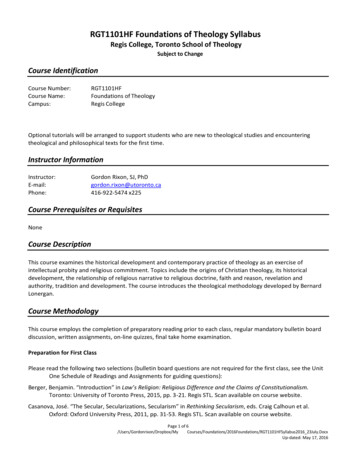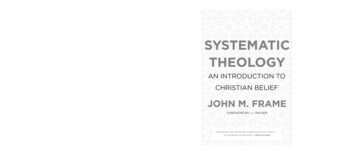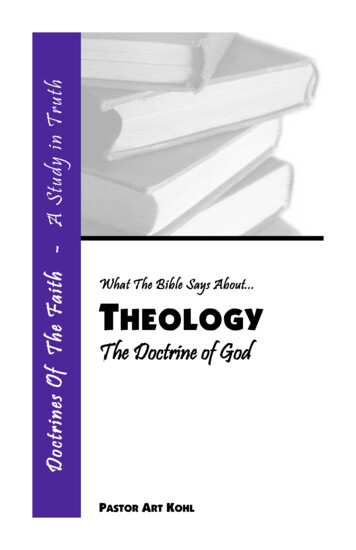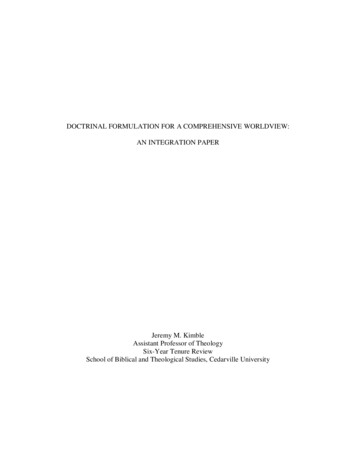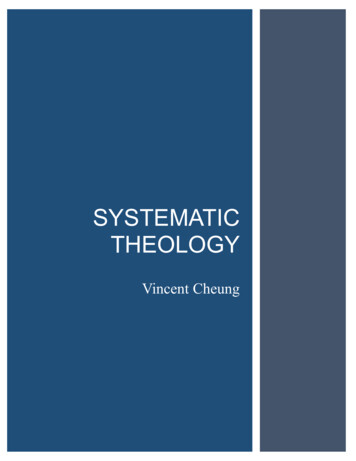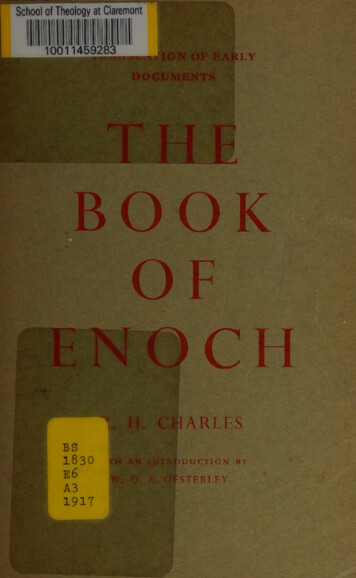
Transcription
iinSchool ofTheology atClaremont TARLES- DUCTION OESTERLEY.ae
The Libraryof theCLAREMONTSCHOOLOF THEOLOGY1325 North College AvenueClaremont, CA 91711-31991/800-626-7820
SHTEXTS(PRE-RABBINIC)eS13221ql’7THEBOOKOF(I ENOCH)ENOCH
dieieOF “ENOCHBOOKBYoH.CHARLES). Litt, -D-D;WITHREv.ANINTRODUCTIONBYTHEW. O. E. OESTERLEY,LONDONBe ees ot Mes ois1962D.D.
First published in 1917Tenth impression,1962oh. As.Holy Trinity ChurchMarylebone RoadLondon N.W.1Theology LibrarySCHOOL OF THEOLOGYAT CLAREMONTCaliforniaPrinted in Great Britain by Richard Clay andCompany Ltd.,Bungay, Suffolk
WE desire to express our hearty thanks toCanon Charles and the Delegates of the OxfordUniversity Press for their permission to reprinthere the translation given in their second editionof The Book of Enoch (1912).W. O. E. OESTERLEY.G. H. Box.
EDITORS’PREFACETHE object of this series of translations is primarilyto furnish students with short, cheap, and handytext-books,which,it is hoped,willfacilitatestudy of the particular texts in class underpetent teachers.volumesBut it is also hopedwill be acceptablethecom-that theto the generalreaderwho may be interested in the subjects with whichthey deal. It has been thought advisable, as ageneral rule, to restrict the notes and comments toa small compass; more especially as, in most cases,excellent works of a more elaborate character areavailable.Indeed,it is muchto be desiredthatthese translations may have the effect of inducingreaders to study the larger works.Our principal aim, in a word, is to make somedifficult texts, important for the study of Christianorigins, more generallyscholarly translations.accessiblein faithfulandIn most cases these texts are not available in acheap and handy form. In one or two cases textshave been included of books which are availablein the official Apocrypha; but in every such casereasons exist for putting forth these texts in a newtranslation, with an Introduction, in this series.W. O. E. OESTERLEY.G. H. Box.
INTRODUCTIONTHEAPOCALYPTICLITERATUREAs the Book of Enoch is, in some respects, the mostnotable extant apocalyptic work outside the canonicalScriptures, it will not be inappropriate to offer a fewremarks here on the Apocalyptic Literature generally.In writing about the books which belong to thisliterature, Prof. Burkitt says very pointedly that“they are the most characteristic survival of whatI will venture to call, with all its narrownessand itsincoherence, the heroic age of Jewish history, the agewhen the nation attempted to realize in action thepart of the peculiar. people of God.It ended incatastrophe, but the nation left two successors, theChristian Church and the Rabbinical Schools, eachof which carried on some of the old national aims.And of the two it was the Christian Church thatwasmostfaithfulto the ideas enshrinedin theApocalypses, and it did consider itself, not withoutsome reason, the fulfilment of those ideas. What iswanted, therefore, in studying the Apocalypsesis,above all, sympathy with the ideas that underliethem, and especially with the belief in the New Age.And those who believe that in Christianity a new Erareally did dawn for us ought, I think, to have thatsympathy. . . . We study the Apocalypses to learnhow our spiritual ancestors hoped against hope thatGod would make all right in the end; and that we,their children, are here to-day studying them is an invu
viiiINTRODUCTIONdication that their hope was not wholly unfounded.” 2Hope is, indeed, the main underlying motive-powerwhich prompted the writers of the Apocalypses.And this hope is the more intensive and ardent inthat it shines forth from a background which is darkwith despair; for the Apocalyptists despaired of theworld in which they lived, a world in which the godlywere of no account, while the wicked seemed too oftentriumphant and prosperous.With evil everywherearound, the Apocalyptists saw no hope for the worldas it was; for such a world there was no remedy,only destruction; if the good were ever to triumphit must be in a new world. Despairing, therefore,of the world around them, the Apocalyptists centredtheir hope upon a world to come, where the righteouswould come to their own and evil would find noplace. It is this thought which underlies the openingwords of the Book of Enoch:‘‘ The words of theblessing of Enoch, wherewith he blessed the electand righteous, who will be living in the day of tribulation, when all the wicked and godless are to beremoved.”Nowhere in this book is the essence ofthis hope more beautifully expressed than in a shortmetrical piece in the first chapter:“But with the righteous He will make peace,And will protect the elect,And mercy shall be upon them.“And they shall all belong to God,And they shall all be prospered,And they shall all be blessed.“ And He will help them all,And light shall appear unto them,And He will make peace with them ” (1 Enoch i. 8).In all the books belonging to this literature whichhave come down to us this hope is expressed more or1 Jewish and Christian A pocalypses, pp. 15, 16 (1913).-
INTRODUCTIONixless vividly; nor is the dark background wanting,with prophecies of coming wrath.It will, therefore,be realized that the Apocalyptic Literature is almostwholly concerned with the future; it is true thatagain and again the Apocalyptist glances at thecontemporary history of the world around him, towhich many a cryptic reference is made—a fact whichnecessitates some knowledge of the history of thisperiod (circa 200 B.C.—A.D. 100) for a full understandingof the books in question—but these references areonly made with a view to comforting the oppressedand afflicted with the thought that even the mostmighty of earthly powers are shortly to be overthrown by the advent of the new and glorious erawhen every injustice and all the incongruities of lifewill be done away with.So that every reference tothe present is merely a position taken up from whichto point to the future.the ApocalyptistsNow, since, as we have seen,despair of anybettering of thepresent world, and therefore contemplate its destruction as the preliminary of the new order of things,they look away from this world in their visions ofthe future; they conceive of other-worldly forcescoming into play in the reconstitution of things, andof society generally ; and since these ave other-worldlyforces the supernaturalplays a greatpart in theApocalyptic Literature. This supernatural colouringwill often strike the reader of this literature asfantastic, and at times bizarre; but this should notbe permitted to obscure the reality which often liesbehind these weird shadows.Mental visions are notalwayseasily expressedin words;the seerwhoina vision has received a message in some fantasticguise necessarily has the impress upon his mind ofwhat he has seen when giving his message; and whenhe describes his vision the picture he presents is,in the nature of the case, more fantastic to the earof the hearer than to the eye of him who saw it.Allowance should be made for this; especially by usWesterns who are so lacking in the rich imaginative-
xINTRODUCTIONness of the Oriental.Our love of literalness hindersthe play of the imagination because we are so aptto “materialize’”” a mental picture presented byanother. The Apocalypses were written by and forOrientals, and wecannotdo justice to themunlesswe remember this; but it would be best if we couldget into the Oriental mind and look at things fromthat point of view.Another thing which the reader of the ApocalypticLiterature must be prepared for is the frequentinconsistency of thought to be found there, togetherwith variableness of teaching often involving contradiction. The reason of this is not to be soughtsimply in the fact that in the Apocalypses the handof more than one author is frequently to be discerned,a fact which would easily accountfor divergenceof views in one and the same book—no, the chiefreason is that, on the one hand, the minds of theApocalyptists were saturated with the traditionalthoughts and ideas of the Old Testament, and, onthe other, they were eagerly absorbing the newerconceptions which the spirit of the age had broughtinto being. This occasioned a continual conflictof thoughtharmonizeintheirminds;theendeavourthe old and the new wouldtonot alwayssucceed, and in consequence there often resulted acompromise which was illogical and which presentedcontradictions.Inconsistency of teaching on certainpoints is, therefore, not surprising under thecircumstances.Again, to realize the significance of much that isfound in these Apocalypses one has to reckon with arigid predestinarianism which was characteristic ofthe Apocalyptists as a whole. They started withthe absolute conviction that the whole course of theworld, from beginning to end, both as regards itsphysical changes and also in all that concerns thehistory of nations, their growth and decline, and ofevery single individual, was in every respect pre-determined by God Almighty before all time.‘This
INTRODUCTIONxibelief of the Apocalyptists is well illustrated in oneof the later Apocalypses by these words:“For He hath weighed the age in the balance,And by number hath He numbered the seasons;Neither will He move nor stir things,Till the measure appointed be fulfilled.”(ii. (iv.) Esdras iv. 36, 37.)Thus ‘“‘the times and periods of the course of theworld’s history have been predetermined by God.The numbers of the years have been exactly fixed.This was a fundamental postulate of the Apocalyptists,who devoted much of their energy to calculations,based upon a close study of prophecy, as to the exactperiod when history should reach its consummation. . . the underlying idea is predestinarian.”1Butall these things, according to the Apocalyptists, weredivine secrets hidden from the beginning of the world,but revealed to God-fearing men to whom wasaccorded the faculty of peering into the hidden thingsof God and of understanding them; upon these menwas laid the privilege and duty of revealing the divinesecrets to others, hence their name of Apocalyptistsor ‘‘revealers.””It was because the Apocalyptistsbelieved so firmly in this power which they possessedof looking into the deep things of God that theyclaimed to be able to measure the significance ofwhat had happened in the past and of what washappening in the present; and upon the basis of thisknowledge they believed that they also had thepower, given them by God, of foreseeing the march ofwhenthe endof the world would come, a consummationfutureevents;aboveall, of knowingtowardswhich the whole history of the world had been tendingfrom the beginning.In spite of all the mysticism, sometimes of a ratherfantastic kind, and of the frequently supra-mundanevision with which the Apocalyptic Literature abounds,1G. H. Box, The Ezva Apocalypse, pp. 35, 36 (1912).
xiiINTRODUCTIONthe Apocalyptists fully realized the need of practicalreligion; they were upholders of the Law, the loyalobservance of which they regard as a necessity forall God-fearing men. In this the Apocalyptists wereat one, in principle, with Pharisaism;but theirconception of what constituted loyal observance ofthe Law differed from that of the Pharisees, for,unlike these, the Apocalyptists laid all stress on the —spirit of its observance rather than upon the letter.Characteristic of their attitude here are the wordsin r Enoch v. 4:“ But ye—ye have not been steadfast, nor done thecommandments of the Lord,But ye have turned away, and have spoken proudand hard wordsWith your impure mouths against His greatness,O ye hard-hearted, ye shall find no peace.”And again, in xcix. 2:“Woe to them that pervert the words of uprightness,And transgress the eternal Law.”We do not find in this Literature that insistenceon the literal carrying-out of the minutest preceptsof the Law which was characteristic of Pharisaism.Veneration for the Law is whole-hearted; it is thereal guide of life; punishment awaits those whoignore its guidance; but the Pharisaic interpretationof the Law and its requirements is alien to the spiritof the Apocalyptists.As a whole, the ApocalypticLiteraturepresentsan universalistic attitude very different from thenationalistic narrowness of the Pharisees.It is true,the Apocalyptists are not always consistent in this,but normally they embrace the Gentiles equally withthe men of their own nation in the divine scheme ofsalvation; and, in the same way, the wicked who are
INTRODUCTIONxiiiexcluded are not restricted to the Gentiles, but theJews equally with them shall suffer torment hereafteraccording to their deserts.!The Apocalyptic Literature, as distinct from theApocalyptic Movement owing to which it took itsrise, began to come into existence about the period200-150 B.C.; at any rate, the earliest extant exampleof this Literature—the earliest portions of the Bookof Enoch—belongs to this period. Works of anApocalyptic character continued to be written forabout three centuries; the Second (Fourth) Book ofEsdras, one of the most remarkable Apocalypses,belongs to the end of the first Christian century,approximately.There are Apocalypses of later date,some of subordinate interest are of much later date;but the real period of the Apocalyptic Literature isfrom about 200 B.c. to about A.D. 100; its beginningsdate, therefore, from a time prior to that great land-mark in Jewish history, the Maccabean Era,THEBookoF ENocH: 1TS COMPONENTTHEIR DATESPARTSANDThe Book of Enoch is now usually designated1 Enoch, to distinguish it from the later Apocalypse,TheSecretsof Enoch,knownasformer is also called the Ethiopicthe Slavonic Enoch, after theearliest versions extant of eachmanuscript of the original languageto be in existence.2Enoch.TheEnoch, the latterlanguages of therespectively.Noof either is knownAccording to Canon Charles, the various elementsof which our book in its present form is made upbelong to different dates.The following table willshow the dates of the different parts of the book.Canon Charles believes that these are approximately1 The general Pharisaic point of view regarding this maybe gathered from Matt. iii. 7-10.
XIVINTRODUCTIONcorrect, without committing himself to the certaintyof this in each case:CHAPTERSXil.—XXXVI.xCiii.“The Apocalypse of }The oldest pre-Macxci. 12-17 J .Weeks.”vi.—xi.ee Gecabean portions.al Fragments of “‘ The Pre-Maccabeans:Xv.-lxix. 25CViss-CVileIxxxiii.-xc.Book of Noah.”“ Theatthe latest.Dream- Visions,” 165-161 B.c.Ixxii.-Ixxxii. “The Book of the Heavenly Luminaries.” Before IIo B.C.XxXXvii. Ixxi. ‘‘ The Parables,”or “‘ Similitudes.”circa 105-64 B.C.xci. I-11, 18, Ig—iv.iv. The latest portion, but pre-Christian.Chaptercv,whichconsistsof only twoverses,cannot be dated; while cviii. is in the nature of anappendix, probably added subsequently, to the wholework.While these dates may be regarded as approximately correct, it should be pointed out that differences of opinion exist among scholars on the subject.Schiirer holds, for example, that, with the exceptionof chapters xxxvii.—lxxi. (the “‘ Parables,” or “ Similitudes”), the entire book belongs to the period130-100 B.c.;the “ Parables’ he assigns to a timenot earlier than Herod the Great. Beer thinks thatthe “ Dream-Visions ” (chapters 1xxxiii.—xc.) belongto the time of John Hyrcanus (135-105 B.c.), and heincludesunderthepre-Maccabeanxci. 12-17, xcil. xciii. I-14;portionsonlyand holds that the restof the book was written before 64 B.c. Dalmanmaintains that it cannot be proved that the importantsection xxxvii. lxxi. (the ‘‘Similitudes’”’) is ‘“ theproduct of the pre-Christian period,” though he fully
INTRODUCTIONXVrecognizes its Jewish character,Burkitt regards thewriter as “almost contemporary ” with the philosopher Posidonius (135-51 B.c.). There is thus somediversity of opinion as to the date of the book amongleading authorities. That it is, as a whole, preChristian, may be regarded as definitely established.More difficult is the question whether any portionsof it are pre-Maccabean;Charles gives variousreasons for his belief that considerable parts are preMaccabeean;weareinclinedtoagreewithhim,though it may be questioned whether the last wordon the subject has been spoken.AUTHORSHIPAs the various parts of the book? clearly belong todifferent dates, diversity of authorship is what oneis naturally led to expect;and of this there can,indeed, be no shadow of doubt.The author of theearliest portions was a Jew who lived, as Burkitthas shown, in northern Palestine, in the land of Dan,south-west of the Hermon range, near the headwaters of the Jordan. This is important, as it tendsto show that the book, or books, is really Palestinian,and one which, therefore, circulated among Jewsin Palestine.‘‘ If, moreover, the author came fromthe north, that helps to explain the influence the bookhad upon the Religion that was cradled in Galilee.” #Of the authors of the other three books of which“Enoch” is made up (viz. “ The Dream-Visions,”“The Book of the Heavenly Luminaries,” and ‘‘ TheSimilitudes ’’) we know nothing save what can begathered from their writings as to their religiousstandpoint.Charles holds that though there is not unity ofauthorship there is, none the less, uniformity;for,1 Burkitt rightly insists that we should speak of the collection as the books, not the book, of Enoch.2 Burkitt, op. cit., 28-30.
xviaccordingINTRODUCTIONto him,all thebookswerewrittenbyChassidim or by their successors, the Pharisees.This contention has been strongly assailed and muchweakened by Leszynsky in a recent work on theSadducees.2Whilefranklyrecognizingthecom-posite character of the book, Leszynsky holds thatthe original portions of it? emanated from Sadduczancircles; and that the special object of the bookoriginally was the bringing about of a reform of thecalendar.He points to the ascription of the bookto Enoch as supporting his contention, for Enochlived 365 years,4 7.e. his years correspond to thenumber of days in the solar year; the basis of reckoning time was one of the fundamental points ofdifference between the Pharisees and Sadducees,for whereas the former reckoned time by the lunaryear (360 days), the latter did so by the solar year.Here a significant remark of Burkitt’s is worthrecalling; in writing about the false titles givento all the Apocalyptic books, he says: ‘There isanother aspect of pseudonymous authorship to whichI venture to think sufficient attention has not beengiven. It is this, that the names were not chosenout of mere caprice; they indicated to a certainextent what subjects would be treated and the pointof view of the writer.”5Further, the fact that“Enoch walked with God; and he was not; forGod took him,” i.e, that he ascended into theheavens, is also significant;be just the oneto knowfor he would therebyall aboutthe heavenlyluminaries ;he was just the most appropriate authorof a book which was to deal with astronomicalquestions.‘‘ The Sadduczean character of the original work,” says Leszynsky, “is seen most clearlyin the discussion regarding the calendar;chapters1 4. e. the ‘‘ Pious ones,” or “ Saints.” Die Sadduzder (1912).34, é., according to him, i.-xxxvi.,XC., XCi. 12-17, xciii.4 See Gen. v. 21-23.Ixxii. Ixxxii.,5 Ob. cit., p. 18.Ixxxiii.- & Gen. v. 24.
INTRODUCTIONxviiIxxii.Ixxxii. are rightly called the Book of Astro-nomy :1 ‘the book of the courses of the luminaries ofthe heaven, the relations of each, according to theirclasses, their dominion and their seasons, accordingto their names and places of origin, and accordingto their months . . . with regard to all the yearsof the world and unto eternity, till the new creationis accomplished which endureth till all eternity’(Ixxii. 1). That sounds almost as though the authorof the Book of Jubilees had written it. That it isnot a merely scientific interest which impels the writerto give expression to his astronomical theories maybe seen from the words at the conclusion of thesection: ‘ Blessed are all the righteous, blessed areall those who walk in the way of righteousness, andsin not as the sinners in the reckoning of all theirdays, in which the sun traverseth the heaven, enteringinto and departing from the portals for thirty days. . ’(Ixxxii. 4 7). Herein one can discern quite clearlythe tendency of the writer. He desires the adoptionof the solar year, while his contemporaries wronglyfollowed a different reckoning, and therefore celebratedthe feasts at the wrong time. The ‘sinners who sinin the reckoning of the year’ are the Pharisees; andthe righteousoneswhoare blessed,the Zaddtkim?who walk upon the paths of righteousness (Zedek)as the name is made to imply, are the Sadducees.” %The point may appear small to us, but we may com-pare with it the Quartodeciman controversy in theChurch during the second century.It is, at any rate,a strong point in favour of the Sadducean authorshipof “The Book of the Heavenly Luminaries.”The pre-Maccabzean portions (assuming that someportions of it ave pre-Maccabean) of the book ofEnoch must certainly be ascribed to the Chassidim ;1 i.e. ‘‘ The Book of the Heavenly Luminaries,” as Charlescalls it.*4.e. “the righteous’’; a play on the word Zaddikim,the “‘ sons of Zadok,”’ 4. e. the Sadducees.8 Leszynsky, op cit., pp. 253 ff.B
XVviiiINTRODUCTIONbut it is not on that account necessary to ascribe allthe later portions to the Pharisees.Three pointsespecially militate against this : some of the teachingconcerning the Messiah; the, generally saic;and the attitude towards the Law, which is not thatof the Pharisees.It is not to be denied that someportions ( . g. cii. 6 ff.) are from the hands of Pharisees ;.nor can it be doubted that the whole collection in itspresent form has been worked over by a Pharisee,or Pharisees;but that all the post-Maccabzanportionsin rmemanatedappeartohavefrombeenIt seems more likely that, with the excep-alreadyreferredto,thevariouscomponentparts of the book were written by Apocalyptists whobelonged neither to Pharisaic nor yet to Sadduczancircles.LANGUAGEThe Book of Enoch exists only in the EthiopicVersion ;this was translated from the Greek Version,of which only a few portions are extant.1 The LatinVersion, which was also made from the Greek, is notextant, with the exception of i. g, and cvi. 1-18;the fragment containing these two passages wasdiscovered by the Rev. M. R. James, of ok was originally written either in Hebrew orAramaic; Charles thinks that chapters vi.—xxxvi.,Ixxxiliixc. were Aramaic, the rest Hebrew.It is,however, very difficult to say for certain which ofthese two languages was really the original, because,1 Chaps. i.—xxxii. 6, and xix. 3-xxi. 9 ina duplicate formwerediscoveredatAkhmim8-xvi. I, and viii. 4-ix.preserved in Syncellus;Vatican MS. (No. 1809);early Greek ecclesiasticalare quoted in the Epistlein1886-1887;vi.—x.14,Xv.4 in a duplicate form, have beenIxxxix. 42-49 occurs in a Greekthere are also a few quotations inwritings; and i. 9, v. 4, XXVii. 2of St. Jude 14, 15.
INTRODUCTIONxixas Burkitt says, ‘‘ most of the most convincing proofsthat the Greek text of Enoch is a translation from aSemitic language fit equally well with a Hebrew oran Aramaic original”; his opinion is that Aramaicwas the original language, “ but that a few passagesdo seem to suggest a Hebrew origin, yet not de-cisively.”’ }GENERALCONTENTSThe reader who comes to peruse the Book of Enochfor the first time will find much that appears to himstrangeandunattractive;he mustnot,however,be repelled by this; for in due time he will come toother parts of the book which he will soon see to beof real value from many points of view. But evenregarding the less attractive parts, he will find thatwhen these are carefully studied they contain morethat is of interest than appears upon the surface.Unfortunately, the opening portion (1.—xxxvi.), whichis naturally read first, contains a good deal of theleast important parts of the whole book; somepassages are even repellent.It is well to rememberthe point, already referred to, that there are at leastfour quite independent books included in the ‘‘ Bookof Enoch,” exclusive of certain “ Noah”’and other pieces (see below);fragmentsthe student is, there-fore, advised to treat these as separate works, andto read them as such. There is nowith the book which happens to comeas the first thirty-six chapters dotogether. But, in any case, it willreason to beginfirst, especiallynot all belongbe found mostuseful to have some general idea of the contents ofeach of the different books before beginning to readthem.For this purposegiven here.a brief résumé of each isInODp. Cit., ps 27:2 It is a great pity that one system of chapter-enumerationruns through the whole volume;if each separate book beganwith chap. i. it would be much better.For obvious reasonsthis cannot be done here; see Editors’ General Preface.
XXINTRODUCTIONi. The Book of Enoch (chapters xii.-xxxvi.). Thebook opens with a Dream-Vision of Enoch. In thisdreamEnoch is asked to intercede for the watchers ofheaven, 7. . the angels, who had left their heavenlyhome to commit iniquity with the daughters of men.He writes out the petition (cp. the title ‘‘ Enoch theScribe’) the fallen angels make, and then retiresto await the answer, which comesto him in a series.of visions. These visions are not quite easy to follow;they are evidently incomplete and somewhat confused; in all probability the text has suffered intransmission.At any rate, the petition is refused ;Enoch declares to the fallen angels the doom which,as he has been taught in the visions, is to be theirlot; the final words of the message which he is biddento give them are: “ You have no peace” (xii.—xvi.).There follow then accounts of the different journeyswhich Enoch makes, being conducted by angels oflight, through certain parts of the earth, and throughSheol. After the account of the first journey (xvii.—xix.) a short enumeration is made of the archangels,seven in number, and their functions (xx.). In thesecond journey is described the place of final punishment of the fallen angels: ‘‘ This place is the prisonof the angels and here they will be imprisoned forever.” From thence Enoch is taken to Sheol ; thento the west, where he sees the luminaries of heaven.After that the angels show him “ seven magnificentmountains,” upon one of which is the throne of God;he sees also the Tree of Life, which is to be given tothe holy and righteous after the great Judgement.From thence he comesback to the centre of theearth and sees the “ blessed place,” Jerusalem, ncludes with what appear to be fragments of otherjourneys, to the east, to the north, and to the south.Of special interest here is the mention of the Gardenof Righteousness, and the Tree of WisdomXXXVi.).(xxviii.—Much that is written in these chapters may appear
INTRODUCTIONxxipointless and uninspiring; butwe must bear in mindthe purpose that lies behind it all. The fallen angelswere believed to have brought sin on to the earth;all the wickedness of the world the Apocalyptisttraces back to them.This cause of sin must bewholly destroyed before righteousness can come trulyTherefore the Apocalyptist has a practo its own.tical aim in view when describing in much detailthe final place of punishment of the fallen angels;for here, too, are to come all those who by sin are theNo less does he delight inoffspring of this race.telling of the abode of joy prepared for the righteous.That all these descriptions were constructed out ofthe imagination of the Apocalyptist, based largely,no doubt, upon popular tradition, did not detractfrom their practical value for the people of his day.He was a preacher of righteousness who lookedforward in absolute conviction to the final overthrow of sin; and all his visions have as their motivepower the yearning for and belief in the triumphof righteousness over sin. One of a like mind wrotelater on, in a kind of preface to his book, these significant words, which sum up the essence of the teachingof this book:And destroy all the spirits of the reprobate, and thechildren of the Watchers, because they have wronged mankind.Destroy all wrong from the face of the earth, andlet every evil work come to an end: and let the plant ofrighteousness and truth appear: and it shall prove a bless-ing: the works of righteousness and truth shall be plantedin truth and joy for evermore.ii. TheParables(chaptersxxxvii.lxxi.).Thereare three Parables, or Similitudes, and they all haveas their underlying thought the destruction of eviland the triumph of righteousness, as in the precedingbook.But here some new and important elementsare introduced which give special value to this book.The first parable (xxxviiil.-xliv.) is a prophecy of .coming judgement upon the wicked, and especiallythe kings and mighty ones on the earth. On the
xxiiINTRODUCTIONother hand, the Apocalyptist sees in his vision theabode and resting-places of the righteous who arecontinually praising the ‘‘ Lord of Spirits ” ; this is theusual title given to God in this book. Here occursthe first mention of the ‘‘ Elect One ”’ (cp. Luke xxiii.35).In the presence of the Lord of Spirits are alsothe four Archangels and innumerable companiesof other angels. Here he learns many secrets of the heavens; a fragment on Wisdom (xlii.), whichrecalls some passages in Ecclus. xxiv., comes in themiddle of the secrets, and is clearly out of place. Thesecond parable (xlv.-lvii.) continues the same themeand further develops it. Of special importance isthe sitting of the Elect One on the throne of gloryas Judge (xlv. 3), and the mention of His title, “ Sonof Man” (xlvi. 2). The thought of the vindicationof the righteous is marred by their joy at vengeanceupon the wicked. A
THE BOOK OF ENOCH (I ENOCH) dieie BOOK OF “ENOCH BY oH. CHARLES). Litt, -D-D; WITH AN INTRODUCTION BY THE REv. W. O. E. OESTERLEY, D.D. LONDON Be ees ot Mes ois 1962 . First published in 1917 Tenth impression, 1962 oh. As. Holy Trinity
